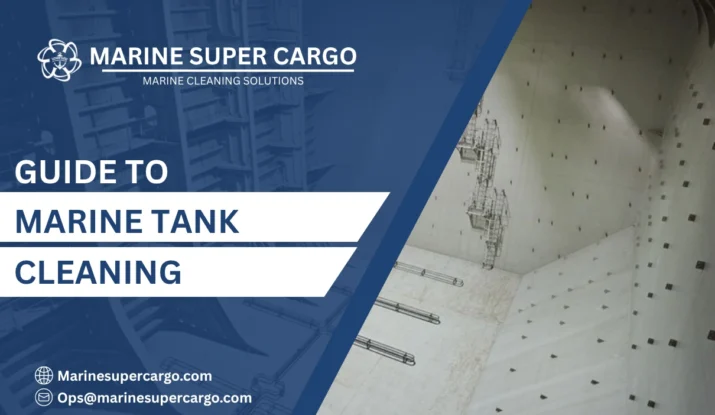Understanding Marine Tank Cleaning Fundamentals
Marine tank cleaning is a critical operation aboard vessels that ensures cargo safety, prevents contamination, and maintains regulatory compliance. Whether dealing with cargo tanks on tankers or ballast tanks on bulk carriers, proper cleaning procedures safeguard both crew and environment while optimizing vessel operations.
The process involves removing residues, sediments, and harmful substances from tanks using specialized equipment and approved methods. This operation requires strict adherence to MARPOL regulations and IMO guidelines to prevent marine pollution.
At Marine Super Cargo, we understand that marine tank cleaning demands precision, safety awareness, and environmental responsibility. Our comprehensive approach ensures vessels meet international standards while minimizing operational downtime.
Why Marine Tank Cleaning Matters
Marine tank cleaning prevents cross-contamination between different cargo types, especially when switching from crude oil to refined products or chemicals. Marine Tank Cleaning Without proper , residues can compromise cargo quality, leading to financial losses and damaged reputation.
Regular also prevents corrosion within tanks. Saltwater residue, chemical deposits, and hydrocarbon sludge accelerate metal deterioration, shortening tank lifespan. Clean tanks enhance structural integrity and reduce maintenance costs over time.
Environmental compliance through marine tank cleaning protects our oceans. MARPOL Annex I specifically addresses pollution from oil, requiring vessels to maintain proper tank cleaning procedures and waste disposal methods.
Essential Marine Tank Cleaning Methods
Hand Cleaning Method
Hand cleaning involves crew members entering tanks to manually remove residues using shovels, scrapers, and brushes. This marine tank cleaning method suits heavy sludge removal and tight spaces where machines cannot reach. However, it poses significant safety risks requiring confined space entry protocols and proper ventilation.
Machine Cleaning Method
Portable tank cleaning machines use high-pressure jets to spray cleaning agents throughout the tank. This automated marine tank cleaning approach reduces crew exposure to hazardous atmospheres while delivering consistent results. Machines rotate 360 degrees, reaching all surfaces from the tank’s centerline to port and starboard bulkheads.
Fixed Installation Systems
Modern tankers feature permanently installed marine tank cleaning systems with strategically positioned nozzles. These systems provide efficient cleaning from bow to stern without crew entry, significantly enhancing safety. Fixed systems comply with IMO requirements for crude oil washing (COW) operations.

Step-by-Step Marine Tank Cleaning Process
1. Pre-Cleaning Assessment
Before commencing , survey the tank condition. Identify residue types, measure gas concentrations, and ensure all cargo lines are properly isolated. Check ventilation systems operate correctly from forward to aft sections.
2. Ventilation and Gas Freeing
Proper ventilation removes explosive atmospheres and toxic gases. Open all tank hatches and activate blowers, allowing fresh air circulation throughout port and starboard compartments. Monitor gas levels continuously during operations.
3. Washing Operations
Begin from the tank top, working downward. Use appropriate washing mediums—hot water for crude tanks, chemical solvents for persistent residues. Maintain proper pressure and temperature according to MARPOL guidelines.
4. Residue Removal
Pump out loosened residues and washing solutions to slop tanks or reception facilities. Never discharge untreated tank cleaning residues overboard. Marine Super Cargo ensures all waste handling follows IMO MEPC resolutions.
5. Final Inspection
After marine tank cleaning, conduct thorough inspections. Check all surfaces—bottom plating, longitudinal bulkheads, transverse frames, and overhead structures. Verify cleanliness meets cargo requirements and certification standards.
Best Practices for Safe Marine Tank Cleane
Always obtain proper permits before operations. Ensure adequate personal protective equipment for all personnel involved. Maintain emergency response equipment ready at tank access points.
Follow the vessel’s safety management system procedures strictly. Never rush operations—proper execution prevents accidents and ensures quality results. Conduct pre-entry tests even when using remote cleaning systems.
Coordinate marine tank cleaning with port authorities when alongside. Verify reception facilities can accept tank washing residues. Document all operations in the Oil Record Book as required by MARPOL Annex I.
Environmental Considerations in Marine Tank Cleaning
Marine tank cleaning generates significant waste requiring proper disposal. Oily residues, chemical contaminated water, and sediments must reach approved reception facilities. Marine Super Cargo prioritizes eco-friendly solutions minimizing environmental impact.
Consider using biodegradable cleaning agents when feasible. These products effectively remove residues while reducing harmful discharge risks. Always verify cleaning chemicals comply with IMO environmental standards.
Conclusion
Effective protects cargo integrity, crew safety, and marine environments. By following established procedures, maintaining equipment properly, and adhering to MARPOL requirements, vessel operators ensure successful operations.
Trust Marine Super Cargo for expert guidance on marine tank cleaning operations that meet international standards.
FAQs About Marine Tank Cleaning
Q1: How long does marine tank cleaning typically take?
Marine tank cleaning duration varies based on tank size, cargo residue type, and cleaning method used. Typically, machine cleaning takes 8-24 hours, while hand cleaning may require several days for heavily contaminated tanks.
Q2: What safety precautions are mandatory during marine tank cleaning?
Essential precautions include gas testing, proper ventilation, confined space permits, personal protective equipment, emergency rescue equipment standby, and continuous atmospheric monitoring throughout operations.
Q3: Can vessels discharge tank cleaning residues at sea?
No, MARPOL Annex I strictly prohibits discharging tank cleaning residues into the sea. All residues must be retained onboard or discharged to approved reception facilities in port.
Q4: What temperature should water be for effective marine tank cleaning?
Hot water between 60-80°C (140-176°F) proves most effective for removing crude oil and heavy petroleum residues. However, temperature requirements vary based on cargo type and tank coating specifications.
Q5: How often should cargo tanks undergo cleaning?
Frequency depends on cargo types carried. Tanks require cleaning when switching between incompatible cargoes, during dry-docking inspections, or when cargo contamination risks exist. Chemical carriers may clean tanks between every cargo.


